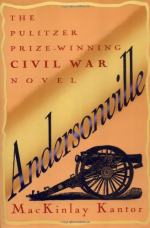The situation of the fort was on a narrow and low spit of ground between Cape Fear River and the ocean. On this the Rebels had erected, with prodigious labor, an embankment over a mile in length, twenty-five feet thick and twenty feet high. About two-thirds of this bank faced the sea; the other third ran across the spit of land to protect the fort against an attack from the land side. Still stronger than the bank forming the front of the fort were the traverses, which prevented an enfilading fire These were regular hills, twenty-five to forty feet high, and broad and long in proportion. There were fifteen or twenty of them along the face of the fort. Inside of them were capacious bomb proofs, sufficiently large to shelter the whole garrison. It seemed as if a whole Township had been dug up, carted down there and set on edge. In front of the works was a strong palisade. Between each pair of traverses were one or two enormous guns, none less than one-hundred-and-fifty pounders. Among these we saw a great Armstrong gun, which had been presented to the Southern Confederacy by its manufacturer, Sir William Armstrong, who, like the majority of the English nobility, was a warm admirer of the Jeff. Davis crowd. It was the finest piece of ordnance ever seen in this country. The carriage was rosewood, and the mountings gilt brass. The breech of the gun had five reinforcements.
To attack this place our Government assembled the most powerful fleet ever sent on such an expedition. Over seventy-five men-of-war, including six monitors, and carrying six hundred guns, assailed it with a storm of shot and shell that averaged four projectiles per second for several hours; the parapet was battered, and the large guns crushed as one smashes a bottle with a stone. The garrison fled into the bomb-proofs for protection. The troops, who had landed above the fort, moved up to assail the land face, while a brigade of sailors and marines attacked the sea face.
As the fleet had to cease firing to allow the charge, the Rebels ran out of their casemates and, manning the parapet, opened such a fire of musketry that the brigade from the fleet was driven back, but the soldiers made a lodgment on the land face. Then began some beautiful cooperative tactics between the Army and Navy, communication being kept up with signal flags. Our men were on one side of the parapets and the Rebels on the other, with the fighting almost hand-to-hand. The vessels ranged out to where their guns would rake the Rebel line, and as their shot tore down its length, the Rebels gave way, and falling back to the next traverse, renewed the conflict there. Guided by the signals our vessels changed their positions, so as to rake this line also, and so the fight went on until twelve traverses had been carried, one after the other, when the rebels surrendered.
The next day the Rebels abandoned Fort Caswell and other fortifications in the immediate neighborhood, surrendered two gunboats, and fell back to the lines at Fort Anderson. After Fort Fisher fell, several blockade-runners were lured inside and captured.




